161 Best Sights in Netherlands
Sorry! We don't have any recommendations for Netherlands right now.
We’ve compiled the best of the best in Netherlands - browse our top choices for the top things to see or do during your stay.
Begijnhof
This tree-filled courtyard is a residential hideaway where women of the Beguine order lived a chaste, spiritual life from the 14th century onward. Number 34 is the oldest house in Amsterdam—one of two remaining wooden houses in the city following 15th-century fires that consumed three-quarters of the city. The small Engelse Hervormde Kerk (English Reformed Church) dates to the 14th century, when it was a place of worship for the Begijnen. After the Alteration of 1578 the church was relinquished to Protestants. When senior Begijn Cornelia Arents died in 1654, she said she'd rather be buried in the gutter than in the (now Protestant) church. Her wish was granted; look for the granite slab and plaque on the wall between the church and lawn.
Binnenhof and the Ridderzaal
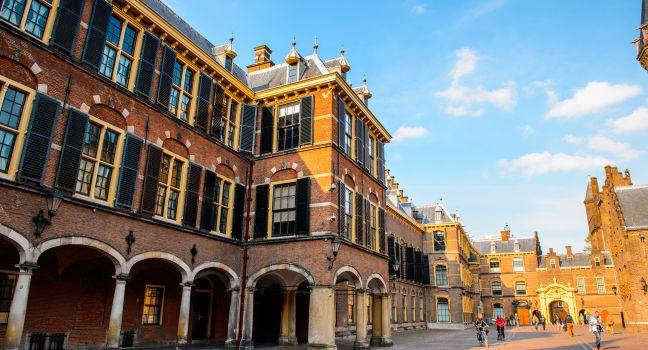
The governmental heart of the Netherlands, the Binnenhof (or Inner Court) complex is in the very center of town yet tranquilly set apart, thanks to the charming Hofvijver (court lake). The setting creates a poetic contrast to the endlessly dull debates that go on within its walls—the basis of everyday Dutch politics. Pomp and decorum are in full fig every third Tuesday of September, when Queen Beatrix arrives at the 13th-century Ridderzaal, or Knights' Hall, in a golden coach to open the new session of Parliament.
For many centuries the Binnenhof was the court for the Counts of Holland; it is now a complex of buildings from several eras. As you enter, the twin-turreted former castle of the Earls of Holland dominates the scene. The castle was originally built by Count Floris V and became a meeting hall for the Knights of the Order of the Golden Fleece (one of the most regal societies of the Middle Ages). Their Great Hall simply drips with history: there are vast wooden beams, flags of the Dutch provinces, and a massive rose window bearing coats of arms. In 1900 the hall was restored to its original 13th-century glory. It is still called Knights' Hall, and you can almost feel the feasts and revelries that took place here. The room still plays a key role in Dutch legislative life.
The Binnenhof also incorporates the halls used by the First and Second Chambers of Parliament (equivalent to the U.S. Senate and House of Representatives). You can wander freely around the open outer courtyard, but entrance to the Knights' Hall and other interior rooms is by guided tour only. The vaulted reception area below the Knights' Hall contains a free exhibition detailing the political history of the Low Countries.
Buy tickets for guided visits at the ProDemos visitor center at Hofweg 1, across the road from the west entrance to the Binnenhof.
Recommended Fodor's Video
Bloemgracht
Lined with traditional burgher houses of the 17th century, this quaint canal is beloved by locals and visitors alike. Many say it's the most pictureseque canal in the city. This was once a center for paint and dye manufacturers, which makes sense because the Jordaan was populated with Golden Age artists—including Rembrandt, who had a studio here. Bloemgracht is still proudly presided over by "De Drie Hendricken," three houses set at Nos. 87–91 owned by the Hendrick de Keyser heritage organization, with their gable stones for a farmer, a city settler, and a sailor.
Brouwersgracht
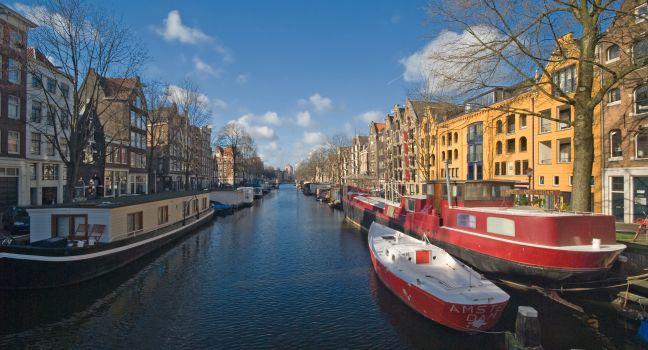
Regularly voted Amsterdam's most beautiful street, this wonderful canal at the northern border of the Jordaan is lined with residences and former warehouses for the brewers, fish processors, and tanneries who operated here in the 17th century when Amsterdam was the "warehouse of the world." On top of the old canal, mansions dotting the Brouwersgracht are symbols referring to the breweries that used this waterway to transport their goods to thirsty drinkers hundreds of years ago. Although most of the buildings have been converted into luxury apartments, an old-world charm still reigns. Of particular note are buildings at Nos. 204–212, with their trapezium gables. At No. 162, there are two dried fish above the door; this decoration on a metal screen was the forerunner of the gable stone to denote occupation. The canal provides long views down the grand canals that are perfect for photo ops.
Escher in Het Paleis Museum
First known as the Lange Voorhout Palace, this lovely building was originally the residence of Caroline of Nassau, daughter of Prince Willem IV; in 1765 Mozart performed for her here. In 2001 the palace was transformed into a museum devoted to Dutch graphic artist M. C. Escher (1892–1972), whose prints and engravings of unforgettable imagery—roofs becoming floors, water flowing upward, fish transforming into birds—became world famous in the 1960s and '70s. Replete with ever-repeating Baroque pillars, Palladian portals, and parallel horizons, Maurits Cornelis Escher's visual trickery presages the "virtual reality" worlds of today. Fittingly, the museum features an Escher Experience where you don a helmet and take a 360-degree digital trip through his unique world. Concave and convex, radical metamorphoses, and dazzling optical illusions are on view in the impressive selection of his prints (including the famed Day and Night and Ascending and Descending); distorted rooms and video cameras make children big and adults small; and there are rooms that are Escher prints blown up to the nth degree. Don't forget to look up as you walk around—dangling glitteringly from the ceiling is a series of custom-designed chandeliers by Dutch sculptor Hans van Bentem that are inspired by Escher's work. These delightfully playful creations include umbrellas, sea horses, birds, and even a giant skull and crossbones. The €26.50 family ticket makes a visit with the kids even more attractive.
EYE Film Institute Netherlands
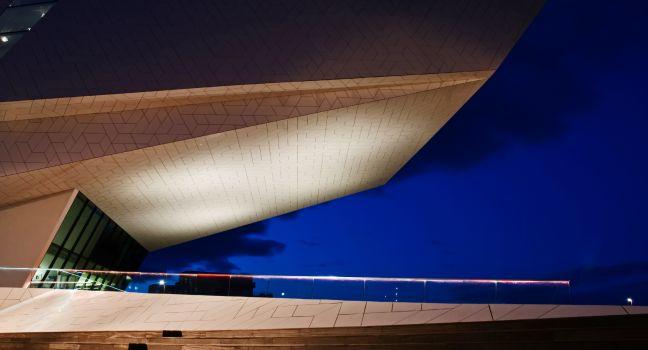
In an eye-popping, proto-futuristic waterfront structure designed by Viennese architects Delugan Meissl, this cutting-edge museum and archive is easily accessible, thanks to a free two-minute ferry ride from Centraal Station. Along with restoring thousands of films (Martin Scorsese used footage from Georges Méliès films restored here in his film Hugo), the institute contains four massive screening rooms (showing a fine mix of classic and contemporary films), a large permanent display with historical objects, set photos and interactive elements from the cinematic world, and a library open to the public. The EYE, whose name is a pun on the pronunciation of IJ, also organizes wonderful changing exhibitions about film-related subjects. They do not take cash—just credit or debit cards. There is also a restaurant with a waterfront terrace and terrific views.
Frans Hals Museum
Named after the celebrated man himself, this not-to-be-missed museum holds a collection of amazingly virile and lively group portraits by the Golden Age painter, depicting the merrymaking civic guards and congregating regents for which he became world famous. The building itself is one of the town's smarter hofjes: an entire block of almshouses grouped around an attractive courtyard. In the 17th century, this was an oudemannenhuis, or home for elderly men, so it is only fitting that their cottages now form a sequence of galleries for the paintings of Hals and other 17th-century masters of the Haarlem School, along with period furniture, antique silver, and ceramics.
Many of the works on display represent Hals at his jovial best—for instance, the Banquet of the Officers of the Civic Guard of St. Adrian (1624–27) or the Banquet of the Officers of the St. George Militia (1616), where the artist cunningly allows for the niceties of rank (captains are more prominent than sergeants, and so on down the line) as well as emotional interaction: he was the first painter to have people gaze and laugh at each other in these grand portraits.
As respite from nearly 250 canvases, step into the museum's courtyard—lovely, and planted with formal-garden baby hedges, of which you get only fleeting glimpses as you work your way through the galleries (most of the blinds are shut against the sunlight to protect the paintings). In one room, with curtains drawn for extra protection, is
From mid-March to mid-May, during bulb season, the museum is made even more resplendent, with a liberal splash of tulip bouquets and other floral art displays adding extra color to the galleries and hallways.
Gemeentemuseum Den Haag
One of the finest examples of 20th-century museum architecture was designed by H. P. Berlage (the grand Old Master of modern Dutch architecture) and completed in 1935. Although the collection ranges from A to Z—Golden Age silver, Greek and Chinese pottery, historic musical instruments, and paintings by Claude Monet and Vincent van Gogh—the museum is best known for the world's largest collection of works by Piet Mondrian (1872–1944), the greatest exponent of Dutch artistic movement De Stijl. The crowning masterpiece, and widely considered one of the landmarks of modern art, is Mondrian's Victory Boogie Woogie, an iconic work begun in 1942 but left unfinished at the artist's death. The painting's signature black-and-white grid interspersed with blocks of primary color arrived only in 1998, when the Netherlands Institute for Cultural Heritage controversially paid 80 million guilders for the (then American-owned) work. Also be sure to see the dollhouse with real doll-size Delft Blue chinaware. Elsewhere, the museum's Costume Gallery contains no fewer than 55,000 items (not all are on display at one time), providing endless inspiration for dedicated students of fashion.
Hermitage Amsterdam
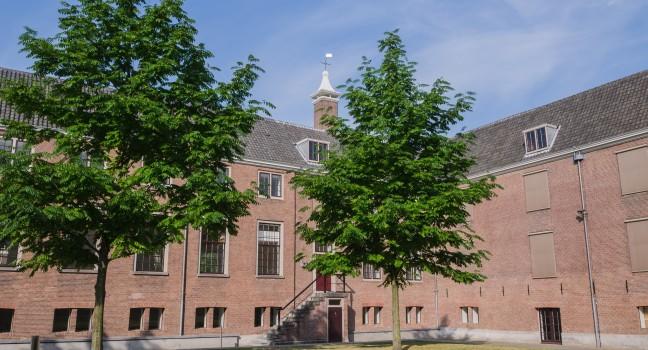
Taking advantage of 300 years of historical links between Amsterdam and St. Petersburg, the directors of the State Hermitage Museum in St. Petersburg and of the Nieuwe Kerk museum in Amsterdam chose this spot on the Amstel for a new outpost. In 2009, the final refurbishment stage of the former home for the elderly Amstelhof was completed, with high white interiors and smaller side rooms connected by long unadorned corridors. The amount of exhibition space is actually much smaller than you might imagine from the outside (or from the entry price), but the quality of the shows is generally excellent.
Het Scheepvaartmuseum
Designed by Daniël Stalpaert in 1656 as an arsenal for the Admiralty of Amsterdam, this excellent example of Dutch Classicism became the new home of the Maritime Museum in the 1970s. Even if you're not much of a nautical fan, the building alone is worth a visit. The courtyard (free) of the biggest remaining 17th-century arsenal was roofed over with a 200,000-kg (440,925-pound) glass-and-steel construction, the design of which is a reference to wind roses and compass lines on old nautical charts. In the daytime, the roof casts ever-changing shadows on the courtyard floor (weather permitting); at night, hundreds of LED lights on the rafters create the fairy-tale illusion of a star-spangled sky.
The museum itself has one-room exhibitions, each with a different theme. The East wing houses an impressive collection of maritime objects, with paintings (the pen drawings by 17th-century master marine painters Ludolf Backhuysen and Willem van de Velde the Elder are particularly beautiful), one of the most important globe collections in the world, nautical instruments, yacht models, and all sorts of symbolic ship decorations. Moored on the jetty outside is the Scheepvaartmuseum’s biggest draw: a life-size replica of a 1748 ship of the Dutch East India Company (VOC). The original left for Asia shortly after it was built, but wrecked off the English coast. Exploring the ship while trying to imagine how people were able to live here for months on end is fascinating.
Kasteel de Haar
The spectacular Kasteel de Haar is not only the largest castle in the Netherlands, but also the most sumptuously furnished. Thanks to the fortuitous way the Barons van Zuylen had of marrying Rothschilds, their family home grew into a Neo-Gothic extravaganza replete with moat, fairy-tale spires, and machicolated towers. The castle was founded back in 1165, but several renovations and many millions later, the family expanded the house under the eye of P.J.H. Cuypers, designer of Amsterdam's Centraal Station and Rijksmuseum, in 1892. Inside the castle are acres of tapestries, medieval iron chandeliers, and the requisite ancestral portraits snootily studying you as you wander through chivalric halls so opulent and vast they could be opera sets.
You can view its grand interiors only via one of the guided tours (no kids under age 5), which leave on the hour and are led only in Dutch. No matter, the objects of beauty on display can be understood in any language. Once you explore this enchanted domain, you'll easily understand why Marie-Hélène van Zuylen, who grew up here, went on to become Baroness Guy de Rothschild, the late 20th century's "Queen of Paris," famous for her grand houses and costume balls. Directions for car travelers are given on the castle website. For public transport, take Bus No. 127 leaving hourly from Vleuten Station, direction Breukelen/Kockengen, until the Brink stop in Haarzuilens, a 15-minute walk from the castle.
Keukenhof
This famed 79-acre park and greenhouse complex is one of the largest open-air flower exhibitions in the world, and draws huge crowds during the eight weeks it's open (late March–mid-May). Founded in 1950 by Tom van Waveren and other leading bulb growers, its hothouses and lakeside flower beds see as many as 7 million tulip bulbs bloom every spring. In the last weeks of April (peak season) you can catch tulips, daffodils, hyacinths, and narcissi all flowering simultaneously. There are also blooms on show in the pavilions along with floral demonstrations and exhibitions about the history of tulips. Leading Dutch bulb-growing exporters use it as a showcase for their latest hybrids, which does mean that commercial—not creative—forces are at play here.
Some of the planting is of the rather gaudy tulip varieties, and there's no holding back on the bulb-buying opportunities. It's lovely—if squashed at times—to wander around meandering streams, placid pools, and paved paths. The avenues were designed by Zocher, of Amsterdam's Vondelpark fame. Keukenhof's roots reach back to the 15th century, when it was the herb farm (Keukenhof means "kitchen courtyard") of one of Holland's richest ladies. Any sense of history has almost been obliterated, although there is a historical garden re-creating the oldest botanical garden in the Netherlands in Leiden and at least a nod to contemporary trends in the "Inspiration" section. Head for the windmill for some calm and a vista over the surrounding fields, or view the crowds from a distance with an hour-long boat tour (book this near the windmill, €9). This is the Netherlands' most popular springtime attraction, and it's easy to reach from all points of the country. Traveling independently rather than in an organized group should present no problem—just follow the crowds, but you can buy a ticket that includes bus transportation.
Tickets are €1.50 cheaper if booked online in advance.
Kinderdijk
The sight of Kinderdijk's 19 windmills under sail is magnificently and romantically impressive. Not surprisingly, this landmark sight (on the UNESCO World Heritage list) is one of the most visited places in the Netherlands. These are water-pumping mills whose job was to drain water from the Alblasserwaard polder enclosed by the Noord and Lek rivers—a function now performed by the 1950 pumping station with its humongous water screws, which you pass on the way to the site. The somewhat chocolate-boxy name (which means "children's dyke") comes from a legend involving a baby in a cradle who washed up here after the great floods of 1421, with a cat sitting on its tummy to keep them both from tumbling out.
Rarer than ever, these windmills date all the way back to 1740. Just 150 years ago, 10,000 windmills were in operation across the country, but today only 1,000 remain. These have been saved from the wrecking ball thanks to the help of heritage organizations. The windmills are open in rotation, so there is always one interior to visit. A walk through a working windmill gives fascinating insight into how the millers and their families lived. The mills can be seen in full action (wind permitting) on Saturday 1–5 pm in July and August, as well as on National Windmill Day (second Saturday and Sunday of May), and National Monument Day (second weekend of September). Throughout the first week following the first Monday of September, the mills are illuminated at night. You can walk around the mill area whenever you like, so it's a great way to spend a leisurely afternoon. There are a couple of cafés for snacks, but if the weather is good bring a picnic.
Kröller-Müller Museum
Many connoisseurs rank this as the third most important museum of art in the Netherlands, after the Rijksmuseum and the Vincent van Gogh Museum in Amsterdam. Opened in 1938, it is the repository of a remarkable private collection of late-19th-century and early-20th-century paintings, the nucleus of which are 91 paintings and 175 works on paper by Van Gogh (about 50 of which rotate on display at any given time) that, when combined with the collection in the Amsterdam museum, constitutes nearly four-fifths of his entire oeuvre. Hélène Kröller, née Müller, had a remarkable eye as well as a sixth sense about which painters created art for the ages and through her family firm, run by her husband, the means to bankroll it. For Vincent, fame came too late; for the Kröller-Müllers, however, their great Van Gogh holdings helped make this museum world famous.
But Hélène Kröller-Müller was not myopic in her appreciation and perception. She augmented her collection of Van Goghs with works by Georges Seurat, Pable Picasso, Odile Redon, Georges Braque, and Piet Mondrian. The museum also contains 16th- and 17th-century Dutch paintings, ceramics, Chinese and Japanese porcelains, and contemporary sculpture. The building itself, designed by Henry Van de Velde, artfully brings nature into the galleries through its broad windows, glass walkways, and patios. The gardens and woods around the museum form a stunning open-air gallery, the largest in Europe with a collection of 20th-century sculptures that include works by Auguste Rodin, Richard Serra, Barbara Hepworth, Alberto Giacometti, and Jean Dubuffet. There is a gift shop and self-service restaurant on-site.
Madurodam
Statistically, the Dutch are the tallest people in Europe, and never must they be more aware of their size than when they visit this miniature version of their own land. Set in a sprawling "village" with pathways, tram tracks, and a railway station, every important building of the Netherlands is reproduced here on a scale of 1:25. Many aspects of Dutch life, ancient and modern, are also on view: medieval knights joust in the courtyard of Gouda's magnificent Town Hall; windmills turn; the famous cheese-weighing ritual is carried out in Alkmaar; and a harbor fire is extinguished.
Thirty interactive points enable visitors to operate the awe-inspiring Delta Works storm surge barrier (constructed after the disastrous flooding of 1953), closing it to hold the ocean at bay and save villages from drowning. Or you can make a plane take off at Schiphol Airport, or load and unload container ships in the Port of Rotterdam.
Madurodam has two restaurants, a picnic area, and a playground, and the entire exhibit is surrounded by gardens. It is located in the woods that separate The Hague from the port of Scheveningen to the north. To get here, take Tram No. 9 from either railway station in the city center.
Maritiem Museum Rotterdam
A sea lover's delight, the Maritiem Museum or Maritime Museum contains Rotterdam's noted nautical collection. Appropriately perched at the head of the Leuvehaven harbor, it was founded by Prince Hendrik in 1874. The seafaring ways of old Rotterdammers make more sense set against the background of modern and historical maritime objects. The main exhibit on the ground floor is a large model of the Europoort, which shows how the Rotterdam area has developed over the centuries into the major seaport of today. The upper floors are mainly given over to rotating exhibitions on seafaring themes. Children have half a floor dedicated to them, called "Professor Plons" (Professor Plunge), where museum staff are on hand to help with looking through a real periscope, donning a hard hat, and taking to the driving seat of a scaled-down crane, and engaging in many other aquatic and maritime activities. Outside the museum, a dozen or so old tugs and barges are moored along Leuvehaven. The wharf is also home to a number of cranes salvaged from ports around the country, and these are particularly striking when floodlighted at night.
Markthal
Mauritshuis
One of Europe's greatest museums, the Mauritshuis offers an incomparable feast of art, including no fewer than 14 Rembrandts, 10 Jan Steens, and 3 Vermeers. The latter's remarkable View of Delft takes pride of place; its rediscovery in the late 19th century assured the artist's eternal fame. In the same room is Vermeer's (1632--75) most haunting work, Girl with a Pearl Earring, which inspired Tracy Chevalier's 1999 best-selling novel as well as its 2003 film adaptation. For something completely different, look to Jan Steen (1626--79), who portrayed the daily life of ordinary people in 17th-century Netherlands. His painting The Way You Hear It Is the Way You Sing It is particularly telling. Don't miss local boy Paulus Potter's vast canvas The Bull, complete with steaming cow dung; the 7-foot-by-11-foot painting leaves nothing to be said on the subject of beef on the hoof.
As an added treat, the original building itself is worthy of a 17th-century master's brush: a cream-color mansion tucked into a corner behind the Parliament complex and overlooking the Hofvijver River. It was built around 1640 for one Johan Maurits, Count of Nassau-Siegen and governor-general of Dutch Brazil. The pair behind its creation, Jacob van Campen and Pieter Post, were the two most important Dutch architects of their era. This truly is one of the finest museums in Europe.
Museum Het Prinsenhof
A former dignitary-hosting convent of St. Agatha, the Prinsenhof Museum is celebrated as the residence of Prince William the Silent, beloved as Vader des Vaderlands (Father of the Nation) for his role in the Spanish Revolt and a hero whose tragic end here gave this structure the sobriquet "cradle of Dutch liberty." The complex of buildings was taken over by the government of the new Dutch Republic in 1572 and given to William of Orange for his use as a residence. On July 10, 1584, fevered by monies offered by Philip II of Spain, Bathasar Gerard, a Catholic fanatic, gained admittance to the mansion and succeeded in shooting the prince on the staircase hall, since known as Moordhal (Murder Hall). The fatal bullet holes—the teykenen der koogelen—are still visible in the stairwell. Today, the imposing structure is a museum, with a 15th-century chapel, a quaint courtyard, and a bevy of elegantly furnished 17th-century rooms filled with antique pottery, silver, tapestries, and House of Orange portraits, along with exhibits on Dutch history.
NEMO Science Center
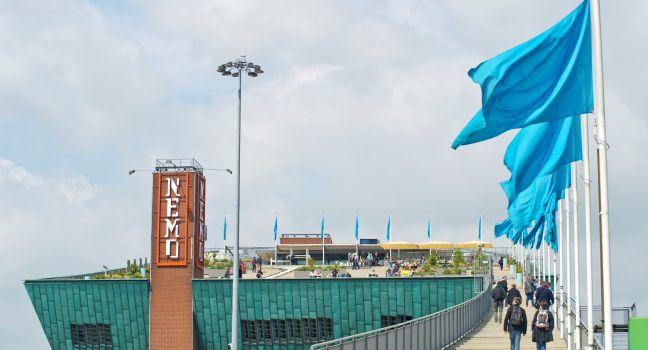
Opened in 1997, this copper-clad building designed by world-renowned architect Renzo Piano (co-creator of Centre Pompidou in Paris, among many other notable projects) is an international architectural landmark—a curved green shape like a ship's bow seemingly rising out of the water, over the IJ Tunnel entrance to Amsterdam North. A rooftop café and terrace offer a superb panorama of the area. It's worth a visit just for the view, but there are also five floors of fantastical, hands-on, high-tech fun, which make this a science wonderland, especially for kids. Attractions range from giant "bubbles" on the ground floor to experiments in the Wonder Lab and interactive exhibitions like Teen Facts.
Rijksmuseum
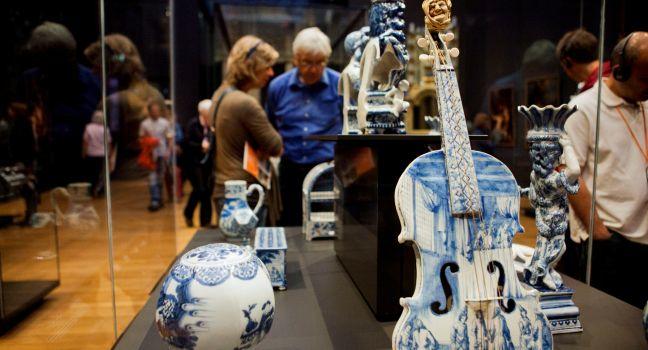
The famed Rijksmuseum houses the largest concentration of Dutch masterworks in the world, as well as paintings, sculpture, and objects from the East and West that provide global context for the history of the Netherlands. Long the nation's pride, this museum has abandoned the art/design/history divisions and has instead combined them into one panoply of art and style presented chronologically, from the Middle Ages to the 20th century. Don't be surprised, in other words, if you spot a vase in a 17th-century painting by Gerard Dou and, next to it, that very same Delft blue-and-white vase itself.
When architect P.J.H. Cuypers came up with a somewhat over-the-top design in the late 1880s, it shocked Calvinist Holland. Cuypers was persuaded to tone down some of what was thought as excessive (i.e., Catholic) elements of his Neo-Renaissance decoration and soaring Neo-Gothic lines. During the building's construction, however, he did manage to sneak some of his ideas back in (including a cheeky statue of himself peeking around a corner), and the result is a magnificent turreted building that glitters with gold leaf and is textured with sculpture.
If your time is limited, head directly for the Gallery of Honor on the upper floor to admire Rembrandt's The Night Watch with its central figure, Frans Banningh Cocq. His militia buddies each paid 100 guilders to be included alongside him—quite a sum in those days, so a few of them complained about being lost in all those shadows. It should be noted that some of these shadows are formed by the daylight coming in through a small window. Daylight? Indeed, The Night Watch is actually the Day Watch, but it received its name in the 18th century when the varnish had discolored—imagine the conservators' surprise. The rest of this "Best of the Golden Age" hall features other well-known Rembrandt paintings as well as works by Vermeer, Frans Hals, and other great artists of the 17th century.
The 20th-century section on the third floor of the two towers includes works by Mondrian and the CoBrA movement, a Nazi chess set (with tanks and cannon instead of castles and bishops), and even a complete Dutch-designed fighter plane, built in 1917 for the Royal Air Force.
In one wing of the ground floor are the Special Collections—room after room of antique furniture, silverware, and exquisite porcelain, including Delftware. An overlooked (and freely accessible) part of this museum is its sculpture garden formed in the triangle by Hobbemastraat and Jan Luijkenstraat. There's a mini-museum in Schiphol Airport (behind passport control), Holland Boulevard between Piers E and F, which is free and open from 6 am to 8 pm daily.
You get a €1 discount if you buy your ticket online (and you get to skip the sometimes long lines).
Royal Concertgebouw
This globally acclaimed concert hall has been home to the Royal Concertgebouw Orchestra, one of the world's greatest, since 1888, and has welcomed an endless stream of top international artists. With a Viennese classicist facade and golden lyre at its peak, this sumptuous example of Neo-Renaissance style, designed by A. L. van Gendt, is a music mecca to more than 700,000 visitors per year. There are three concert halls, and you can attend a free lunchtime concert in one of them (usually Wednesday, September–June) while taking in the atmosphere. Building tours (in English) take place Monday at 5 pm, Wednesday at 1:30 pm, Friday at 5 pm, and Sunday at 12:30 pm; they cost €11.
Spoorwegmuseum
Beyond the converted 19th-century station that serves as the entrance to this excellent museum is a vast exhibition space in the style of a rail yard. In addition to dozens of locomotives, several themed zones take you on a tour of rail history. In the Great Discovery, dealing with the birth of the railways, you follow an audio tour (available in English) through an early-19th-century English coal mine. Dream Journey stages a theater production based on the Orient Express. In Steel Monsters, you sit in carriages and ride the rails, while all around you the bright lights, sounds, and billowing steam evoke the Golden Age of train travel. Outside, kids can ride the Jumbo Express on an adventure trip past lakes and through tunnels and water jets. The museum is an easy walk from the city center; alternatively, trains run between here and Utrecht Centraal Station eight times daily (€2.40 one-way).
Stedelijk Museum of Modern Art
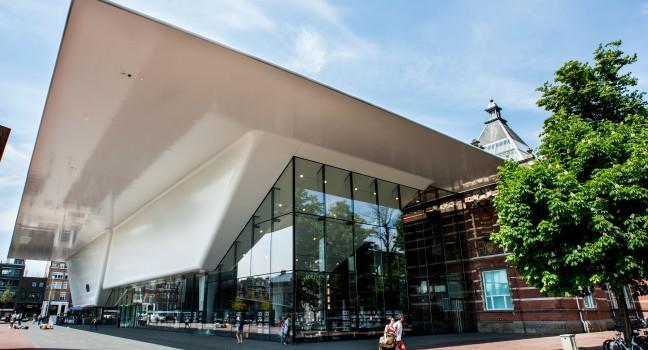
Amsterdam's celebrated treasure house of modern art is housed in a wedding-cake Neo-Renaissance structure built in 1894. In true Amsterdam fashion, locals were quick to nickname the futuristic addition, by globally acclaimed architects Benthem/Crouwel, the "Badkuip" (Bathtub); it incorporates a glass-walled restaurant (which you can visit, along with the museum shop, without a ticket). The new Stedelijk has twice the exhibition space of the old museum, with temporary exhibitions in the extension.
As for the Stedelijk's old building, it's home to the museum's fabled collection of modern and contemporary art and design pieces. While this collection harbors many works by such giants of modernism as Chagall, Cézanne, Picasso, Monet, Mondrian, and Malevich, there is a definite emphasis on the post–World War II period: with such local CoBrA artists as Appel and Corneille (CoBrA was the avant-garde art movement from 1948 to 1951; the name comes from the initials of the members' home cities:
Valkhof Museum
Forgiven (barely) for its aqua hue, boxy exterior "design"—which Emperor Charlemagne, whose castle ruins border the premises, would have decidedly turned his nose up at—the Valkhof Museum is nevertheless a very important archaeological and modern art museum rolled into one. The bright, pleasant space (despite the questionable accordion-style stairway) features a truly fine exhibition of prehistoric, Roman, and medieval artifacts found in the backyards of local residents. A veritable department store of antiquity balanced by a fast-forward selection of Expressionism and Pop Art designed to tease those reluctant to test both waters, the museum also features such showpieces as the oldest wine in all of Europe (no sampling), in a glass bottle some 2,000 years old; a hoot of a drinking vessel in the shape of an owl-like creature with a coconut shell body and silver trim (belief was that if given poison, one could see it in the coconut); and the showstopper, an iron mask with silver and bronze, dating to AD 100 and found nearby in the river.
Van Gogh Museum
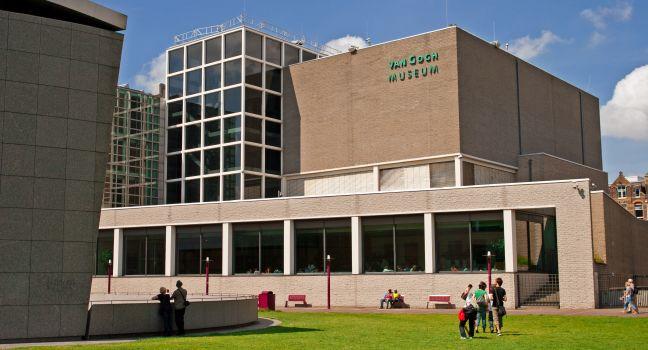
Opened in 1973, this remarkable light-infused building, based on a design by famed De Stijl architect Gerrit Rietveld, venerates the short and productive career of tortured 19th-century artist Vincent van Gogh. Although some of the Van Gogh paintings scattered throughout the world's museums are of dubious provenance, this collection's authenticity is indisputable: its roots trace directly back to Vincent's brother, Theo van Gogh, who was his artistic and financial supporter.
The 200 paintings and 500 drawings on permanent display here can be divided into five basic periods, the first beginning in 1880 at age 27 after his failure in finding his voice as schoolmaster and lay preacher. These early depictions of Belgian and Dutch country landscapes and peasants were notable for their dark colors and a refusal to romanticize. The Potato Eaters is perhaps his most famous piece from this period. In 1886, he followed his art-dealing brother, Theo, to Paris, where the heady atmosphere—and drinking buddies like Paul Signac and Henri de Toulouse-Lautrec—inspired him to new heights of experimentation. While heavily inspired by Japanese woodcuts and their hard contrasts and off-kilter compositions, he also took the Neo-Impressionist obsession with light and color as his own, and his self-portraits (he was the only model he could afford) began to shimmer with expressive lines and dots. With a broadened palette, Vincent returned to the countryside in 1888 to paint still lifes—including the famous series of Sunflowers (originally meant to decorate the walls of a single bedroom in the Maison Jaune he had set up to welcome Paul Gauguin)—and portraits of locals around Arles, France. His hopes to begin an artists' colony there with Paul Gauguin were dampened by the onset of psychotic attacks, one of which saw the departure of his ear lobe (a desperate gesture to show respect for Gauguin—in southern France, matadors had ears cut off of bulls and presented them to their lady loves). Recuperating in a mental health clinic in Saint-Rémy from April 1889, he—feverishly, one assumes—produced famous works like Irises and Wheatfield with a Reaper, whose energetic brushwork powerfully evoke the area's sweeping winds. In May 1890, Van Gogh moved to the village of Auvers-sur-Oise, where he traded medical advice from Dr. Paul Gachet for paintings and etching lessons. The series of vibrantly colored canvases the pained painter made shortly before he died are particularly breathtaking. These productive last three months of his life were marred by depression, and on July 27, he shot himself while painting Tree Roots and died two days later.
In 1999, the 200th anniversary of Van Gogh's birth was marked with a museum extension designed by the Japanese architect Kisho Kurokawa, which provides space for superb temporary exhibitions. In 2015, a glass structure was added to create a new entrance hall on the Museumplein side and to connect the original museum building to the Kurokawa wing.
Tickets are timed and can (and probably should) be purchased in advance since time slots fill up very early in the busy seasons.
Vermeer Centrum
Housed in the former St. Lucas Guild, where Delft's favorite son was dean for many years, the center takes visitors on a multimedia journey through the life and work of Johannes Vermeer. Touch screens, projections, and other interactive features are interspersed with giant reproductions of the master's work, weaving a tale of 17th-century Delft and drawing you into the mind of the painter.
Westergasfabriek
Westergasfabriek
This former gas factory from 1885 is now an arts and cultural center comprising 13 monumental buildings of various shapes and sizes, which house media companies, art exhibitions, food markets, and assorted festivals. There are also bars, nightclubs, restaurants, and a cinema.



